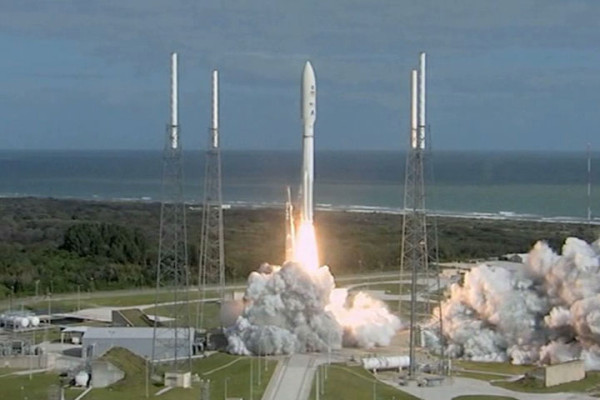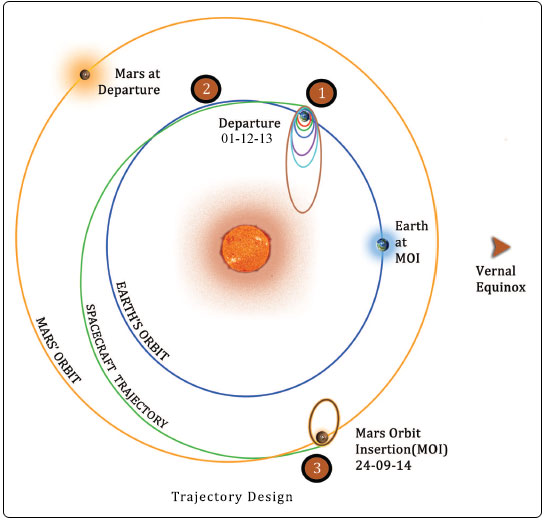“I sometimes catch myself looking up at the Moon, remembering the changes of fortune in our long voyage, thinking of the thousands of people who worked to bring the three of us home. I look up at the moon and wonder, when will we be going back, and who will that be?” -Tom Hanks
Imagine, hopefully, the not-too-distant future, when humanity launches the first manned mission to another planet in our Solar System: probably Mars. You're on your way, and then -- all of a sudden -- you realize that something is wrong.
 Image credit: Frank G., via https://shufti.wordpress.com/2011/11/26/aaa-around-another-airport-2/.
Image credit: Frank G., via https://shufti.wordpress.com/2011/11/26/aaa-around-another-airport-2/.
Maybe the radiation dose is too much, maybe there's been a critical malfunction and landing will be impossible, or maybe someone needs the kind of medical treatment that's only available back on Earth's surface. Whatever the case is, you simply must abort your mission and return home. Could you?
Consider the possibilities of returning home from a mission that was never designed to do so.
- Log in to post comments


I wish I knew more celestial mechanics! Is it really the case that the Hohmann transfer orbit tracks the departure planet? Your diagram shows a "Mars flyby" where the return path meets up directly with Earth's position at that time. Does that flyby involve a change in velocity, or just (effectively) no hitting Mars?
Tom Hanks came back from the Moon? Man that Apollo 13 movie was more realistic that I realized...
By the way, I know SpaceX has talked about pushing the transfer time to mars to 3 or 4 months by using extra energy simply to reduce travel time. They have said there are reducing returns around that timeframe.
The gambling industry wouldn't exist without punters who thrive on risking everything.
The mission to populate Mars does not require a return-to-Earth mission abort plan; it requires only the careful selection of candidates who are prepared to risk everything for the extreme kudos gained from success -- even if the probability of success is vanishingly small.
Most of our greatest explorers truly believed that it's better to die while trying than to try only when there is an adequate safety net in place.
I would never advise reckless behaviour, but modern life would be stuck in miserable antiquity had it not been for the extreme risk-takers.
It is actually just a question of how much delta v you have in your tanks (the amount of velocity adjustment your remaining fuel would provide). With chemical rockets, I suspect that you can't have enough to cut the mission much shorter than the total return time.
Michael Kelsey: There's no implication that a Hohmann transfer will result in a "free return" to the departure planet. Note that Ethan wrote "...use the red planet’s gravity to turn yourself around back towards Earth." By carefully adjusting its close pass by the target planet, the vehicle can obtain a large orbital change in return for a small fuel investment. No booster in existence at launch time was capable of boosting the Cassini probe to Saturn by direct Hohmann transfer, for example, yet it's there, thanks to multiple carefully planned gravity assists along the way.
I can imagine a flight computer capable of calculating multiple possibilities for aborting a mission. Perhaps such a mission would even be scheduled for a planetary alignment with favorable aborting contingencies.
I really hope the EM Drive concept turns out to be real. It probably won't ever eliminate the dependence on chemical rockets but surely the continuous supply of delta v would overcome the gravitational challenges. Outfit an Orion + deep space module with the latest/greatest solar/radioactive/batteries and bring just enough fuel for emergency maneuvering. Problem solved?
@Jeff Berkowitz #5: That's what I thought; thanks. The figure in Ethan's post made it look as though the two trajectory halves formed a simple ellipse, and the Earth interestingly "ended up" in just the right place for the return.
Michael Kelsey: "Ethan’s post made it look as though the two trajectory halves formed a simple ellipse"...
In the simplest ideal case a Hohmann transfer IS in fact a simple ellipse, tangent to both planet's orbits. If there is no change in velocity at the target orbit (and no interaction with a planet's gravity there), the craft WILL automatically return to the first orbit. It's just that the source planet will not be there, but more likely on the opposite side of its orbit! That's why plans for a visit to Mars involve an extended stay there before entering the return trajectory. It might be possible to pass by Mars close enough to enter a much shorter trajectory, passing inside Earth's orbit to return at the right time. But that would take much more energy (reserve fuel).
I do not understand why intelligent and well informed people are so persistent to label MarsOne as a suicide mission. A suicide mission is a mission where death due to unnatural causes is 100% certain. That is NOT the case with MarsOne. MarsOne is an instance where death due to unnatural causes is ELEVATED, but that is not the same thing.
The early Apollo missions were a situation where the risk of death was elevated. If Apollo 13 had resulted in the death of the crew, the fatality rate among Apollo astronauts would have been an astonishing 18%. And yet even if Apollo 13 had resulted in the death of the astronauts, I don't think anyone would have called our exploration of the moon a suicide mission. What if MarsOne can design a mission architecture with greater an 18% odds that we will live out the rest of our lives and die of old age on Mars? Would you still call it a suicide mission?
Colonizing Mars is hard. We get that. But all exploration activities are a matter of weighing risk and reward. And in this early planning phase, it is impossible to say exactly what odds MarsOne will be able to give its colonists on surviving to die of natural causes. We don't know yet what the odds are, but you certainly don't know yet that they are 100%, which is the only criteria where MarsOne could fairly be called a suicide mission.
And a brief note on the radiation issue: The lifetime limit of 1 Sv is NASA's self imposed limit because it is above that dose where it become possible to statistically detect the increased cancer risk. A dose of 1.0 Sv doesn't mean you automatically die or start succumbing to radiation sickness, it just means that that is the point about which your odds of getting cancer start detectably increasing above their baseline odds of ~30%. People may weigh risk differentially, but I would happily be willing to accept an increase in the odds of dying or cancer from 30% to 35% in exchange for living out the rest of my life on Mars. People accept much bigger increases in risks of death by smoking, free diving, or base jumping; decisions that, while others may not personally agree with, we don't consider people to be irrational or suicidal for making.
https://www.facebook.com/MaxFagin.MarsOne